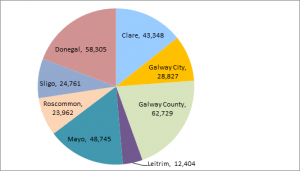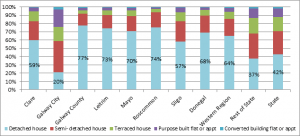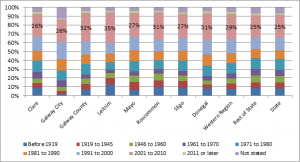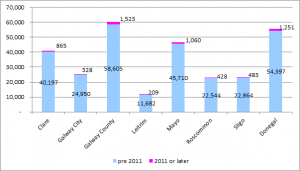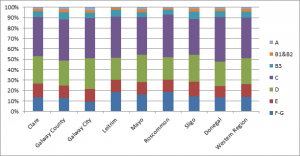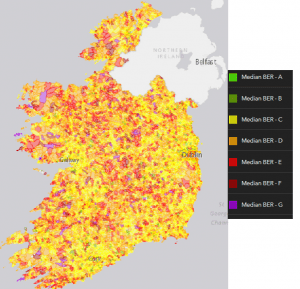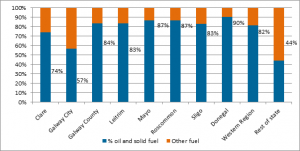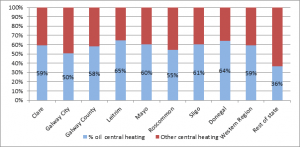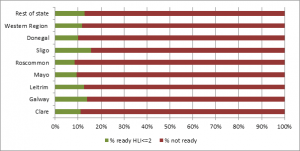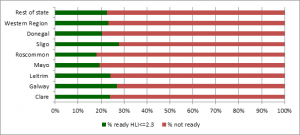//
One of the most important elements of the transition to a low carbon rural region will be emissions reduction from homes in the Western Region by improving energy efficiency and switching to renewable energy sources for heating in particular (as discussed in the last blog post on this topic the focus of current WDC work on the transition is on rural dwellers). The government, in the Climate Action Plan 2019, has set very ambitious targets for improving energy efficiency (retrofitting 500,000 buildings to a much higher level of efficiency (BER B2 or cost optimal or carbon equivalent) and moving to more renewable heat sources (with a target to install 600,000 heat pumps (of which 400,000 will be in existing buildings). In order to understand how what needs to be done to meet these targets we need to know where we are starting from. This post sets out, in detail, some of the baseline information on homes in the Western Region. Knowing the current situation means that we can better understand what we need to do to make the transition possible and ways to make it happen.
Homes in the Western Region
To understand the challenge it is first useful to look at the number and types of homes in the seven county Western Region. According to Census 2016 there were 303,081 ‘permanent housing units’, that is all permanent residents excluding caravans, mobile homes and other temporary structures, (these accounted for 987 residences in 2016). While newer homes have been built since the Census in 2016, the numbers are relatively small and those homes are not the focus of the efficiency and energy upgrades envisaged in the Climate Action Plan, so the Census remains the key data source. The Western Region, in 2016, accounted for 17.98% of the permanent homes in Ireland which is in line with the share of the population living in the region (17.4%).
Galway county had the largest number of homes (62,729) and when combined with Galway city (as it is in some data discussed below) it has significantly more homes (91,556) than other Western Region counties. Leitrim, the smallest Western Region county, had 12,404 homes (see Figure 1 below).
Figure 1: Permanent homes by county in the Western Region, 2016
Source: CSO Census of Population, Profile 1: Housing in Ireland Table E1002
The types of homes in the Region are also important, given that different types have different levels of energy efficiency and can have different options for switching to more renewable energy sources. For example, terraced houses will have lower heat loss than detached houses while flats and apartments are more suited to a central or district heating systems than more dispersed housing. Figure 2 shows the significance of different housing types in the region and state.
Figure 2: Type of permanent housing units in the Western Region, 2016
Source: CSO Census of Population, Profile 1: Housing in Ireland Table E1002
Clearly, with the exception of Galway city, detached houses are the most common housing type in the region (64% of all homes in the region compared to 37% of homes in the rest of the state). As would be expected the more rural counties have an even higher proportion of detached homes (Leitrim 73%, Roscommon 74%). Counties with a higher urban population (Clare 59%, Sligo 57%) have a smaller proportion of detached homes but all are still above the state average (42%. As noted above this has implications for the types of changes we need to make in relation to efficiency and heat sources.
The age of homes in the region is also important to planning the transition. Figure 3 shows when homes in the different counties were built. Significant house building in all counties between 2001 and 2010 is very apparent, with more than 30% of homes in Galway County (32%), Leitrim (35%), Roscommon (31%) and Donegal (31%) built in that period, while all other Western Region counties also have a higher proportion of homes built in that period than the rest of the state (25%). Homes built in the different periods have different requirements for energy efficiency upgrades, and will face different costs and challenges. The oldest homes will often face the most significant challenges, though it should also be recognised that they are not necessarily the least efficient. More than a quarter of homes in Leitrim (26%) were built before 1960 while only 17% of those in Donegal were. In Galway City only 10% of homes were built before 1960.
Figure 3: Age of homes in the Western Region, 2016
Source: CSO Census of Population, Profile 1: Housing in Ireland Table E1005
While there will be different requirements for transforming homes from different eras, given the more recent improvement in building standards it is generally assumed that homes built after 2010 will require least upgrading and therefore the focus of the SEAI grants, for example for heat pump installation, is on homes built before 2011. Figure 4 shows the proportions of homes in the Western Region built before and after 2011 (excluding those not stated). In most counties, and in the State, only 2% of homes were built from 2011 onward (the exceptions are Galway City (1%) and Galway County (3%).
Figure 4: Number of Homes built pre and post 2011 in the Western Region, 2016
Source: CSO Census of Population, Profile 1: Housing in Ireland Table E1005
Evidently there is a very significant amount of work ahead with almost 98% of homes likely to require energy efficiency upgrades and fuel switching to complete a move to a low carbon economy. There are of course some pre 2011 exceptions such as the small number of homes which were built to higher efficiency standards than required or which have completed the process already).
Efficiency of Homes: Building Energy ratings (BER)
A Building Energy Rating (BER) certificate indicates a building’s energy performance rates on a scale of A-G. A-rated homes are the most energy efficient and G-rated are the least energy efficient. It is calculated through energy use for space and hot water heating, ventilation, and lighting. Figure 5 shows the different energy ratings given to buildings covered in each county up to 2018. In all counties more than 90% of homes achieve a B3 rating or less. While this data is very useful, in most areas fewer than a third of homes (often considerably fewer) have had a BER assessment[1] and so it is not clear if the homes which have been assessed accurately reflect the housing stock.
Figure 5: Percentage of rated buildings in each BER class for Western Region counties, 2019
Source: CSO, 2019, Domestic Building Energy Rating Table EBA02
The Climate Action Plan focus is on improving homes to a BER rating of at least B2 (or cost optimal or carbon equivalent. Currently in the Western Region Galway and Mayo perform best with 5% of homes with a BER rating achieving B2 while only 2% in Leitrim and Roscommon do so.
The SEAI has recently produced an interactive map of BER ratings and with detailed BER data mapped at small area level. Figure 6 below is a snapshot the national map where green DEDs have a median rating of B and above (there are not many on the map), while yellow shows DEDs with A median C rating, orange is D, Red is E, Dark red, F and purple G. The map should be viewed with caution as many DEDs have fewer than 20% of their homes with a BER rating and so the data may be skewed. It is, however, really useful for planning and can be viewed in full here.
Figure 6: Map of median BER ratings by ED
Source: SEAI https://www.seai.ie/technologies/seai-maps/ber-map/
Fuels used in home heating.
While much of the discussion above has related to improving energy efficiency in homes, the other element necessary for reducing the carbon foot print of our homes is the fuel used for heating. We will need to decarbonise the fuels used, by switching to renewable energy which may be electrical (generated from wind, solar or, in future, ocean energy), or bioenergy (e.g. wood energy, biogas from anaerobic digestion or a liquid biofuel).
The highest priorities for change are buildings heated using the most carbon intensive fuels (oil, coal and peat) and homes in the Western Region are particularly reliant on these, being rural, with little access to the natural gas grid and often using very traditional forms of central heating. Figure 7 below shows the percentage use of oil and solid fuels (excluding wood energy) used in homes in the Western Region (from Census 2016). In the Western Region as a whole more than four fifths of homes use oil, coal or peat for central heating, compared with 44% of homes in the rest of the state. In Donegal 9 out of 10 homes use these fuels, with Mayo and Roscommon almost as high (each 87%). Galway city has the lowest use of these fuels in the region (57%) and even that is higher than in the rest of the state. Clearly homes in Western Region counties need to be prioritised in the switch to low carbon heating.
Figure 7: Oil and solid fuel as a percentage of central heating fuels in Western Region counties
Source: CSO Census of Population, Profile 1: Housing in Ireland Table E1053
While much of the discussion on home heat (e.g. in the Climate Action Plan) has focussed on heat pump installation, it may be that homes heated using coal and peat might find a switch to other renewable solid biomass such as wood energy to be more appropriate, especially in older homes which will need very significant retrofitting and may have particular ventilation requirements. The focus of heat pump installation may therefore be on homes heated using oil. Figure 8 below shows the percentage of homes in Region which use oil for central heating.
Figure 8: Oil as a percentage of central heating fuels in Western Region counties
Source: CSO Census of Population, Profile 1: Housing in Ireland Table E1053
Almost 60% of homes in the Western Region use oil for central heating compared to 36% in the rest of the state. Again Galway city is lowest (at 50%) with the highest oil use in Leitrim (65%) and Donegal (64%). A fifth of homes in Galway city (21%) are using electricity for heating which reflects the higher number of flats and apartments there (21%). Roscommon has relatively low oil use (55%) because of the very significant use of peat (27%) to fuel central heating. Homes in Galway county also commonly use peat (23%).
Heat Pump ready?
While it is important to change the type of energy used to heat homes in the Region, as discussed above energy efficiency and good insulation are the first steps which need to be taken with a ‘fabric first’ approach advocated by SEAI for home energy improvement. This is particularly important when heat pumps are to be installed as the home must be well insulated in order for heat pumps to work properly.
SEAI have used Heat Loss Indicator (HLI) data from BER certifications (see more here) to assess how many homes built prior to 2010 are ready to have heat pumps installed. A prerequisite for heat pump installation is a HLI of ≤ 2 W/K/m2 and the percentage of homes ready for heat pump installation in the Western Region is shown in Figure 9 below. Interestingly, this is a similar percentage of homes[2] in the Western Region (11.7%) as in the Rest of the State (12.8%). Sligo is the Western Region county with the highest proportion of heat pump ready homes (15.6%) followed by Galway (14.0%) and Leitrim (12.6%). Roscommon (8.6%) and Mayo (9.3%) have the lowest number of homes ready for heat pumps.
Figure 9: Heat Pump ready homes (HLI ≤2) by Western Region county
Source: https://www.slideshare.net/SustainableEnergyAut/key-learnings-from-the-seai-heat-pump-programme and CSO Census of Population, Profile 1: Housing in Ireland Table E1002. Own calculations.
The HLI of ≤ 2 is the most stringent measure of heat pump readiness, but given the very significant target for heat pump installation in the Climate Action Plan (400,000 in existing homes by 2030) if it also useful to look at other homes which are close to this level of readiness. SEAI have, therefore, also estimated the number of homes which are heat pump ready using a HLI of ≤2.3 with certain caveats (see this for the detail of these).
Using this measure there are a considerably higher proportion of heat pump ready homes (see Figure 10) in the Western Region (23.2%)[3] which is higher than the rest of the State (22.5%). Again Sligo has the most heat pump ready homes (27.8%) with Galway (23.9%), Leitrim (24.1%) and Clare 23.9% all higher than the Region average. The lowest proportion of homes ready for a heat pump is in Roscommon (18%) and Mayo (19.4%).
Figure 10: Heat Pump ready homes (HLI ≤2.3) by Western Region county
Source: https://www.slideshare.net/SustainableEnergyAut/key-learnings-from-the-seai-heat-pump-programme and CSO Census of Population, Profile 1: Housing in Ireland Table E1002. Own calculations.
Although only 23% of homes are currently heat pump ready in the Western Region this still amounts to 65,187 homes in total in the region (and 351,295 in total for the state). Prioritising these homes would make a very significant start on meeting the target in the Climate Action Plan.
Conclusion
In this post I have given some of the baseline information necessary for planning the transformation of our Western Region homes to more energy efficient, low carbon dwellings. Clearly the scale of the transformation required is enormous and some of the issues which need to be addressed and actions which might be put in place will be discussed in my next post.
Helen McHenry
[1] BERs are usually done because a home is to be sold and a BER cert is required for this.
[2] Heat pump ready homes by county is shown as a percentage of permanent homes built before 2011 from CSO Census of Population 2016.
[3] This figure includes all those homes with a HLI of ≤2.0

